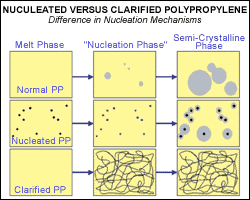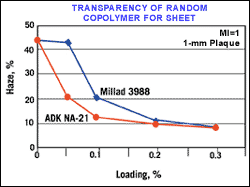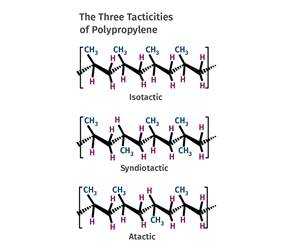New Clarifiers & Nucleators: They Make Polypropylene Run Clearer and Faster
New packaging opportunities are opening up for PP, thanks to a new crop of additives that boost clarity, stiffness, HDT, and processing rates.
Prospects for polypropylene to penetrate further into injection molded, blow molded, and thermoformed packaging rely to a large extent on ad-vanced nucleators and clarifiers. These additives maximize the resin’s aesthetic appeal (clarity) and its processing productivity. They also enhance certain performance properties, namely stiffness and heat resistance. These advantages are attracting a growing roster of suppliers who are bringing out new generations of additives that set new benchmarks for cost-performance.
Clarifiers have been used since the mid-1980s in the medical arena to produce clear, radiation-resistant syringe barrels and lab devices. In recent years, as these additives improved in organoleptic (taste/odor) characteristics and clarifying power, they have strongly influenced growth in PP applications for household containers for food and non-food storage.
Today, deli cups, airline drink cups, and stadium cups of clarified PP are replacing PET and polystyrene. Robert Portnoy, senior staff application scientist at ExxonMobil Chemical, notes that improving clarity is not the only story: By speeding cycles and increasing stiffness (which permits thinner walls), nucleation has helped thermoformed PP cups gain ground from PET and PS even where clarity is not critical. What’s more, Portnoy says that although most of these cup applications are currently thermoformed, nucleation has helped make injection molding more competitive by improving its cycle times. “You are now starting to see nucleation almost as a baseline property of PP,” Portnoy observes. Whereas only a few nucleated grades were offered in the past, they are much more widespread today.
The benefits of nucleation are also being felt far from the packaging realm: In auto parts, nucleators stiffen PP impact copolymers and TPOs, overcoming the softening imparted by rubber modification.
Although most use so far of nucleators and clarifiers has been for injection molded consumer goods and medical devices, these additives have opened doors for thermoformed and blow molded applications (see box). With the exception of stretch-blow molded bottles and some very thin-walled thermoformed parts, even clarified PP generally cannot match the crystal clarity of PET. However, these additives can give sufficient transmission and contact clarity—combined with PP’s higher hot-fill temperatures, lower density, and lower price—to make it a serious competitor for PET.
Several examples are cited by Paul Wright, plant manager at Pechiney Plastics Packaging in Batavia, Ill. He notes that Welch’s Grape Juice dropped glass for a 10-oz multi-layer extrusion blown bottle of clarified PP. Dole Food Co. recently chose an extrusion blow molded jar of clarified PP over glass for its tropical fruit product. Pechiney molded both these packages, as well as a monolayer clarified-PP bottle for Aurora Foods’ Log Cabin table syrup, which was previously produced in APET. “Although not quite as clear as PET, clarified PP has excellent clarity and can better withstand hot-fill temperatures,” Wright explains.
Barry Dean, product-development manager at BP, believes clarified PP can expand in packaging markets even without matching PET’s clarity. He says BP’s 8249 clarified random copolymer is gaining ground in extrusion and stretch-blow molded sports-drink cups, jelly jars, and multi-layer bottles where clarity does not have to be as good as PET.
How they work
Nucleators and clarifiers (a sub-class of nucleators) essentially jump-start the crystallization process as the resin cools. PP normally forms crystals larger than the wavelength of light. Nucleators and clarifiers induce formation of smaller spherulites that scatter less light. What’s more, says Robin Lee, senior research specialist at Dow Plastics, “Since the crystals form faster, the polymer solidifies faster and cooling time is reduced.” All clarifiers will nucleate, but all nucleators do not clarify, although many do provide a significant reduction in haze.
Traditional nucleating agents are mostly aromatic carboxylic-acid salts, of which sodium benzoate is the most common. They have been used in PP homopolymers since the 1960s to improve stiffness and increase processing rates. Talc and other inorganic fillers have also been found to have a nucleating effect. All these choices are limited in their ability to reduce haze, and they also suffer from poor organoleptics and inadequate heat stability.
While traditional nucleators sell for $1.20-1.60/lb, more advanced nucleators and clarifiers sell in the range of $12-18/lb. The latter offer considerable performance enhancements at very low use levels, typically 0.15-0.25%. At such low levels, newer nucleators and clarifiers add 1.5¢ to 4.5¢/lb to the resin cost, vs. 4-5¢/lb a decade ago.
| COOLING-TIME SAVINGS WITH NUCLEATORS IN 35-MFR PPa (Medium-Impact Copolymer, Injection Molded Rectangle 57 x 43 cm, 0.55 kg) | |||||
| Resin Tcb, C | Cooling Time Reduction, % | Modulus, Mpa | Gardner Imp., J @ -30 C | HDT, C | |
| Control | 109 | - | 1060 | 1.8 | 79 |
| Millad 3899c | 124 | 32.4 | 1340 | 1.7 | 95 |
| ADK NA-11d | 125 | 27.8 | 1260 | 1.3 | 102 |
| HPN-68e | 127 | 39.8 | 1270 | 1.8 | 102 |
Of the advanced nucleators that are classified as clarifiers, most are organic derivatives of dibenzylidene sorbitol (DBS). The pioneer in this field is Milliken Chemical, now offering its third-generation DBS-based clarifier, Millad 3988. Other suppliers offer what may be termed first- and second-generation sorbitol acetals. These now include Irgaclear clarifiers produced by Roquette in France and sold here by Ciba Specialty Chemicals, as well as NC-4 clarifier from Mitsui Toatsu Chemicals in Japan, sold here by Mitsui Chemicals.
Sorbitol-based clarifiers melt or dissolve in the polymer at temperatures from 390 to 430 F. When the resin cools, the clarifier crystals form a fine fibrous network that contributes to clarity by providing a very high crystal density with very small spherulites. “Crystallites are reduced to the point that they are less than the wavelength of visible light,” explains Reed Walker, Milliken’s polymer additives product-line manager. Because visible wavelengths are not significantly affected by the small crystallites, resulting parts are much more transparent. Better stiffness and higher HDT also result.
Advanced nucleators (some of which also clarify) include organophosphate salts and other inorganic materials. Until recently, the primary supplier was Asahi-Denka Kogyo of Japan (U.S. subsidiary is Amfine Chemical) with its ADKstab NA-11 and NA-21 phosphate esters. In the past year, Milliken Chemical entered the field with its Hyperform HPN-68, a norbornane carboxylic-acid salt. This new class of high-speed nucleator was recently registered by the FDA for food contact.
Nucleators do not disperse as easily as clarifiers, since they are typically inorganic materials with no solubility in the resin. They rely on dispersion by mechanical methods to nucleate the PP to form the small sphe-rulites, explains Amfine’s director of marketing, Peter Goman. When they are compounded into the polymer, they provide additional sites for nucleation, so spherulites become smaller.
This leads to higher physical properties and some added clarity, depending on the nucleator’s particle size and ease of dispersion. Clarity is said to be enhanced with Amfine’s NA-21 and to a lesser degree with NA-11, Milliken’s HPN 68, and sodium benzoate, in descending order. “In general, the particles of nucleators are larger than the wavelength of light, and that is one reason why you don’t get the clarity imparted by sorbitol-based clarifiers,” explains Milliken’s Walker.
Evolution of clarifiers
Clarifiers such as sorbitol acetals typically provide nucleation (crystallization speed enhancement) as good as that provided by phosphate ester nucleators in PP homopolymers and random copolymers. (Heterophasic impact copolymers, with their two different refractive indexes, cannot be clarified.) However, clarifiers are too costly to be used for nucleation alone if high clarity is not needed. Sorbitol-based clarifiers typically sell for $14-18/lb vs. $13-17/lb for organophosphate nucleators. However, clarifiers are used at higher levels—0.2% to 0.25% for Milliken’s Millad 3988 and Ciba’s Irgaclear clarifiers and 0.3% for Mitsui’s NC-4. Organophosphate salts and other nucleators can be used at 0.1% to 0.15% or less.
Clarity depends in part on the path length the light has to travel. Clarity decreases with increasing part thickness and is also dependent on the degree of orientation imparted during processing. According to Milliken’s Walker, achieving 7% haze is state of the art for injection molded random copolymer, while 9-10% haze can be obtained with injection molded homopolymer. However, stretch-blow molding and thin-wall thermoforming can achieve haze of only 1-2%, approaching the clarity of PET. (All these figures are based on results with Milliken’s Millad 3988.)
Millad 3988 is a third-generation clarifier that made its predecessors—Millad 3905 and 3940—obsolete. First-generation Millad 3905 could not be used at temperatures above 435 F, limiting its suitability for injection molding. Second-generation Millad 3940 could be processed at temperatures up to 480 F and also provided improved clarity, but it had poor organoleptics, which limited its use to medical devices. Millad 3988 reportedly overcame these deficiencies with heat stability up to 535 F plus excellent organoleptics. This allows it to be used in different types of resins with varying melt flows for everything from injection and blow molding to extrusion and thermoforming.
Ciba Specialty Chemicals made its entry into sorbitol-based clarifiers in 1998 with first-generation Irgaclear D and second-generation Irgaclear DM. Ciba recently launched Irgaclear DM-LO, which is said to feature good organoleptic properties, approaching those of Millad 3988. (Milliken sources strongly disagree with that claim.). Panel tests reportedly show that taste and odor have been reduced by half compared with Irgaclear DM. The company is initially testing DM-LO primarily in injection molded household containers but expects eventually to aim for food-packaging uses.
Irgaclear DM-LO is not yet replacing its predecessors. Irgaclear DM is currently used in food packaging, medical syringes, and high-clarity housewares and cosmetics containers. Irgaclear D is still satisfactory for applications like CD boxes where less clarity can be tolerated. Haze value in a 1-mm PP homopolymer plaque is 40% with Irgaclear D and 10-15% with DM and DM-LO. Irgaclear D costs about half as much as Irgaclear DM, while Irgaclear DM-LO sells at a slight premium.
Amfine Chemical recently completed tests at compounder A. Schulman Inc. in Akron, Ohio, where different clarifiers were used in BP’s standard 1.8-MFR random copolymer for blow molding. According to Amfine’s Goman, his firm’s ADK NA-21 at 0.15% use level provided clarity equal to or better than that obtained with Millad 3988 at 0.2% (see graph below).
Goman says organophosphate clarifiers such as ADK NA-21 are well suited to medical syringes, where clarity and high extraction resistance are critical. He says the all-organic sorbitol-based clarifiers are very soluble and therefore more extractable. They are also prone to cause die-lip build-up, requiring frequent mold cleaning or the addition of costly GMS (glycerol monostearate) to the resin to prevent plate-out. (PP suppliers agree with this assessment.) But because NA-21 is difficult to disperse in high-flow PP grades, its use has been limited to thermoforming and blow molding—primarily as a clarifier, Goman notes. He says a new organophosphate salt clarifier now in development is expected to challenge Millad 3988 in injection molding.
Changing benchmarks
PP resin developments are changing the market’s expectations with regard to clarity. Up to now, random copolymers have showed lower haze than homopolymers at a given wall thickness and clarifier concentration. Yet the new metallocene-catalyzed PP (mPP) homopolymers are said to be another story. “We can get a [clarified] homopolymer mPP with the same clarity and stiffness as a Ziegler-Natta [clarified] random copolymer,” says Portnoy at ExxonMobil. A haze value of 8% was obtained in injection molded mPP homopolymer (Achieve 1635E1) vs. 12-14% haze in a Z-N random copolymer when Millad 3988 was used in both at the same concentration.
Mike Musgrave, technical segment manager at AtoFina, says his firm has an mPP homopolymer with only half the haze of a Z-N homopolymer when both are clarified with Millad 3988. Both Finacene EOD-00-35 mPP and AtoFina PP 3289 Z-N PP are 2-MFR extrusion/thermoforming grades with the same flexural modulus (225,000 psi) and HDT (192 F), despite the 19° lower melting point of the mPP. Disposable food containers produced with the clarified mPP have sidewall haze of 15% vs. 31% for the Z-N grade, and bottom haze of 32% vs. 44%. AtoFina has obtained similar results with random copolymers of mPP vs. Z-N PP.
The need for speed
Resin suppliers report good results with advanced nucleators in injection molding and thermoforming. Improvements in cycle times can range from 5% to 40%.
Dow’s Lee cites the example of a non-nucleated resin that can be thermoformed at 1000 cycles/hr. Nucleating the same resin results in about 1500 cycles/hr, he claims. Comments Jennifer Hicks, technical-service representative for Phillips Sumika Polypropylene, “Compared with sodium benzoate, the new nucleators raise the freezing point so material sets up faster, and they can be used at lower concentrations—300 ppm vs. 1000 ppm.”
ExxonMobil is relying on nucleators to re-enter the extrusion/thermoforming market with the launch of PP5082KN. According to Portnoy, this new workhorse Z-N homopolymer is heavily nucleated, which provides significant cycle-time improvements.
Milliken’s new Hyperform HPN-68, claimed to be the most powerful nucleator yet, is under evaluation at several PP suppliers. Results of one test are shown in the table on p. 46.
One disadvantage of very quick crystallization induced by nucleators is the tendency to freeze stresses into the part, which can lead to warpage. This could be an issue particularly with large parts like automotive bumpers and interior trim.
However, Amfine’s Goman points out that both ADK NA-11 and NA-21 are used in impact PP for low-temperature automotive applications. NA-21 tends to promote a little slower crystallization than NA-11 and HPN-68, he says, so in certain applications NA-21 can provide slightly better impact at the expense of some stiffness. The company is preparing to bring out a new class of nucleators expected to prove even more effective for injection molding of high-flow (25-50 MFR) PP.
Ciba Specialty Chemicals is now marketing NA-11 through an agreement with Asahi Denka. Ciba will market the product, which will be made at Amfine Chemical’s plant in Kentucky, under the name Irgastab NA 11. Ciba’s market focus will be on customer-specific additive blends.
Related Content
Fundamentals of Polyethylene – Part 5: Metallocenes
How the development of new catalysts—notably metallocenes—paved the way for the development of material grades never before possible.
Read MoreThe Fundamentals of Polyethylene – Part 2: Density and Molecular Weight
PE properties can be adjusted either by changing the molecular weight or by altering the density. While this increases the possible combinations of properties, it also requires that the specification for the material be precise.
Read MoreFirst Quarter Looks Mostly Flat for Resin Prices
Temporary upward blips don't indicate any sustained movement in the near term.
Read MoreThe Fundamentals of Polyethylene – Part 1: The Basics
You would think we’d know all there is to know about a material that was commercialized 80 years ago. Not so for polyethylene. Let’s start by brushing up on the basics.
Read MoreRead Next
The New Polypropylenes - They've Got More of Everything
Whether it’s toughness, stiffness, heat resistance, clarity, barrier properties, high flow, or high melt strength—you’ll find more of what you’re looking for in new breeds of PP resins from all suppliers.
Read MoreLead the Conversation, Change the Conversation
Coverage of single-use plastics can be both misleading and demoralizing. Here are 10 tips for changing the perception of the plastics industry at your company and in your community.
Read MoreSee Recyclers Close the Loop on Trade Show Production Scrap at NPE2024
A collaboration between show organizer PLASTICS, recycler CPR and size reduction experts WEIMA and Conair recovered and recycled all production scrap at NPE2024.
Read More



























